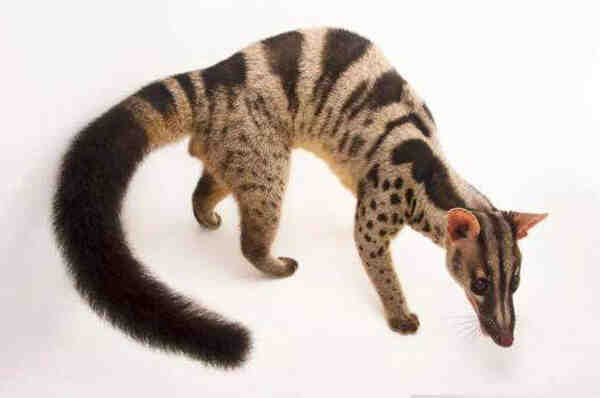Chrotogale owstoni
IUCN
LCBasic Information
Scientific classification
- name:Chrotogale owstoni
- Scientific Name:Chrotogale owstoni,Owston’s Palm Civet,Barred civet, civet, gossip cat, striped civet, striped civet, Euston palm civet
- Outline:Carnivora
- Family:Schizopoda Viverridae
Vital signs
- length:40-66cm
- Weight:2.4-3.4kg
- lifetime:Lack of research
Feature
The "cat" with a "mouse mouth" is actually a raccoon
Distribution and Habitat
Distribution: Distributed in Laos and Vietnam.
Existence uncertain: Cambodia.
Possibly extinct: China (Guangxi, Yunnan) - assessed on March 3, 2015; found in the Daweishan Nature Reserve in Yunnan in 2016.
The long-jawed civet prefers to live in primary and secondary forests below 500 meters above sea level, near water sources, and with dense vegetation. The highest known altitude of the recorded living area is 2,600 meters.
Appearance
Slightly larger than a small civet, the tail length is 60-70% of the body length, and the foot structure is intermediate between the civet subfamily and the civet subfamily. The wrist pads and ankle pads are in contact with the palms and pads, and the widths of the connections are nearly equal. However, the wrist pads and ankle pads have degenerated and shrunk. Except for the innermost leaflet of the palmar pads and plantar pads, the other three lobes are only partially separated by shallow grooves. The surface of the pads is smooth and the gaps between the pads (between toe pads and palm pads) are slightly covered with sparse hair, which are similar to those of the civet subfamily. The central sulcus of the nose is quite special. The central sulcus disappears near the tip of the nose. The middle groove of the front edge of the nose starts from the lip edge and goes up but does not reach the tip of the nose. After passing the tip of the nose, it reappears at the front 1/3 of the dorsum
Details
The Owston’s Palm Civet is a large terrestrial civet with no subspecies. It is very similar in appearance to its other relative, the Banded Palm Civet Hemigalus derbyanus. The only difference to the naked eye is the spots on the neck and limbs, but in fact the Owston’s Palm Civet has a narrower, elongated and more pointed head, larger ears and a slimmer body.

In the 1970s, the South China Mammals of China recorded that a species of civet was acquired in Pingbian, Yunnan and Longzhou, Guangxi. Its face was obviously long and narrow, its snout protruded forward, there was an "eight"-shaped spot on its shoulder, and there were 4 wide and large black horizontal spots on its back. It was named "Long-jawed Civet". Although the introduction is not detailed, it still summarizes the basic appearance characteristics of this civet. Until 2016, many biologists had never seen the true appearance of the "long-jawed civet", and Chinese animal experts were still at the zero stage of research on this species. This species has disappeared in China. In 2016, Xiao Shibai used a trap camera to record the long-jawed civet in the jungle near Vietnam in Yunnan, China. This is the only protected area in China where the long-jawed civet is distributed as of 2016 - Yunnan Dawei Mountain.
The long-jawed civet has a narrow snout, grayish-white body color, and a wide black horizontal stripe on the back; the large black stripes on the left and right shoulders form the shape of the Chinese character "eight", so it is commonly known as the gossip cat. The big black eyes help them get a better view at night.
The zoo that first raised the long-jawed civet fed them chicken like other carnivores, but found that the long-jawed civet often broke its teeth when chewing bones. Field observations revealed that their unique narrow snouts and fine teeth are designed to search for earthworms and other small animals in the thick leaf litter under the forest, rather than to hunt vertebrates. Since only the soil of moist forests is rich in earthworms, the long-jawed bandicoot is extremely dependent on tropical moist forests and never appears in dry forests, making it extremely vulnerable to habitat destruction. Captive breeding programs to protect the species have also been close to failure due to low reproduction rates and high mortality rates.
The long-jawed bandicoot inhabits many protected areas in China (Daweishan National Nature Reserve, Jinping Watershed National Nature Reserve, and Huanglianshan National Nature Reserve). The Chinese population is estimated to be 300 (Wang 1998).
Listed in the "Red List of Endangered Species of the World Conservation Union" (IUCN) 2015 ver 3.1 - Endangered (EN).
Listed in the "National List of Terrestrial Wildlife with Important Economic and Scientific Research Value" issued by the State Forestry Administration of China on August 1, 2000.
Listed in the "Chinese Species Red List" - Endangered (EN).
Listed in the "List of National Key Protected Wildlife in China" - Level I.
Listed in the "Red Data of Endangered Animals in China" - rare.
Listed in the "Convention on International Trade in Endangered Species of Wild Fauna and Flora" (CITES) - Level II.
Listed in the "List of Wild Animals Protected by the State and Autonomous Region in Guangxi, China".
Protect wild animals and eliminate game.
Maintaining ecological balance is everyone's responsibility!








